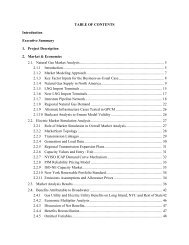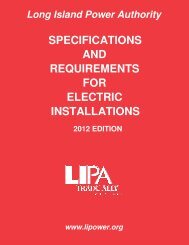Appendix E-2.c.i Energy Plan 2004-2013 Follow-up Studies and ...
Appendix E-2.c.i Energy Plan 2004-2013 Follow-up Studies and ...
Appendix E-2.c.i Energy Plan 2004-2013 Follow-up Studies and ...
Create successful ePaper yourself
Turn your PDF publications into a flip-book with our unique Google optimized e-Paper software.
Re-powering Study for the Northport <strong>and</strong> Port Jefferson Power Stations<br />
<strong>Appendix</strong> II Northport System Descriptions<br />
2.5.4 Steam Turbine Gl<strong>and</strong> Sealing Steam<br />
Auxiliary steam is provided to the steam turbine gl<strong>and</strong> sealing system during shutdown periods when the<br />
Steam Turbine is maintained is a warm or hot condition as well as during Steam Turbine start-<strong>up</strong> <strong>and</strong> low<br />
load operations. At higher Steam Turbine loads gl<strong>and</strong>-sealing steam is provided from the HP gl<strong>and</strong><br />
leakoff(s). Excess HP gl<strong>and</strong> leakoff steam is bled off to the condenser by means of a steam packing<br />
unloader valve.<br />
Auxiliary steam is provided to the steam turbine gl<strong>and</strong> sealing steam system through a flow control valve.<br />
Steam is used to seal the turbine gl<strong>and</strong>s to prevent the steam from being expelled to the atmosphere <strong>and</strong> to<br />
prevent air from leaking into the turbine through the gl<strong>and</strong> seals.<br />
A steam seal feed valve <strong>and</strong> a steam packing unloading valve is provided to maintain the system at a<br />
constant pressure. A steam seal feed bypass valve is used to provide a means to maintain steam pressure<br />
in the event of failure of the control valve <strong>and</strong> for plant start<strong>up</strong>.<br />
2.6 Air Cooled Condenser/Steam Turbine Exhaust<br />
Refer to PID-03-12A in <strong>Appendix</strong> III.<br />
The Air Cooled Condenser system condenses steam from the LP exhaust of the steam turbine <strong>and</strong> returns<br />
condensate to the condensate tank <strong>and</strong> to the HRSG condensate system. This system will be provided on<br />
The Backyard Option at Northport <strong>and</strong> is composed of the following equipment necessary to condense the<br />
steam <strong>and</strong> return the condensate to the condensate storage tank. These items are:<br />
1. Air-cooled steam condenser tower.<br />
2. Air-flow control equipment.<br />
3. Wind <strong>and</strong>/or cell-partition walls.<br />
4. Steam-bypass heating system.<br />
5. Air removal equipment.<br />
6. Steam ducts <strong>and</strong> expansion joints.<br />
7. Condensate drain <strong>and</strong> air-removal piping.<br />
8. Instrumentation, controls <strong>and</strong> alarms.<br />
9. Pressure-relief device for protection of steam-turbine exhaust casing.<br />
10. Steam-duct condensate drain system.<br />
11. Condensate Storage Tank<br />
The air-cooled condenser includes tube bundles, a steam distribution manifolds, fans, motors, gear boxes<br />
<strong>and</strong> s<strong>up</strong>porting steel. Steam from the turbine exhaust, or bypass station, flows through a main steam duct<br />
to a roof-shaped air-cooled condenser. The steam is then condensed inside the finned tube bundles using<br />
ambient air as the cooling medium. The cooling air is provided by axial fans, which are driven by electric<br />
motors via speed reducing gearboxes. At the bottom outlet of the finned tubes, the condensate is collected<br />
in condensate manifolds <strong>and</strong> flows by gravity to the main condensate tank. The condensate flowing to the<br />
tank is partially reheated with steam coming from the main steam duct via the equalization line. The<br />
condensate in the tank is then pumped back to the boiler feed water system. At the lowest point of the<br />
steam duct, a condensate sump collects entrained moisture from the steam turbine exhaust flow <strong>and</strong> the<br />
steam that is condensed on the steam duct walls. The accumulated condensate is then gravity drained to<br />
the main condensate tank. The condenser design consists of seven rows (streets) of six cells each for a<br />
March 30, 2009 160






